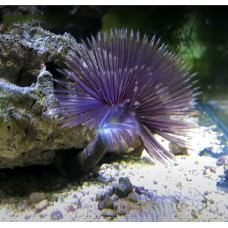Class of ringed worms. Known since the Cambrian. Most live in the sea - on the bottom, near the bottom or in the water column. Body length from 1 mm to 1 m and more. The body is made up of segments (up to 200). The prostomium usually has sensitive appendages (tactile antennae on the dorsal side and palps - on the ventral side), eyes and chemoreceptor ciliary fossae.
The peristomium, which carries the mouth opening, is represented by a single segment or formed by several fused segments. The remaining body segments have lateral fleshy appendages - parapodia, which may be single or double-lobed, with dorsal and ventral antennae and gill appendages.
The parapodia bear numerous bristles (hence the name of the worms): some of them are grouped in bundles and stick out; others, stronger, are located inside and have a supporting function.
The anal lobe (pygidium) is usually equipped with sensitive antennae and sometimes eyes. The body of swarming and especially sessile species usually has two or three segments, which differ in the structure of the parapodia. Sessile species have developed tentacles to collect small organic particles, which are directed into the water column or spread over the bottom surface.
Circulatory system usually closed.
Nervous system in the form of an abdominal nerve chain with octopharyngeal ring and supraglottic ganglia.
Predominantly separate sexes, there are hermaphrodites. The gonads are arranged in many or strictly defined segments. Gametes are freely suspended in the coelomic fluid and are excreted externally through metanephridia, special sex ducts (gonoducts) or by rupture of the body. Fertilisation is usually external. Many species rise from the bottom into the water column during reproduction. The egg gives rise to a spherical larval trochophore, which in many species is able to feed and live for long periods as part of the plankton. During metamorphosis, the first hemisphere of the trochophore is transformed into a pre-rotatory blade, and in the posterior part of the second hemisphere segments begin to differentiate. Many species grow throughout life by continuous formation of new segments in the growth zone anterior to the anal lobe.
About 8,000 species; distributed all over the world. In addition to marine species, there are several freshwater and terrestrial species; there are parasitic species. Aquatic mnogschitinkovyh worms move freely, dig temporary shelters. Some species are almost motionless sit in their built tubes (leathery, calcareous or glued from grains of sand), in permanent burrows in the ground or in passages made in limestone.
They feed mainly on detritus and there are predators. They play an important role in the food chains of benthic ecosystems, in particular as food for benthic fish.
Polychaeta
Tags: polychaeta




